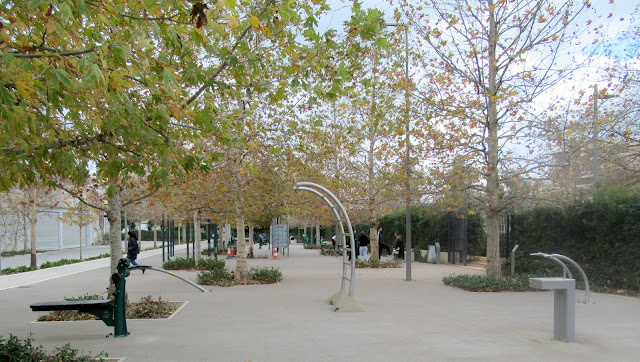We like to visit this massive cultural centre which comprises the Greek National Opera, the National Library, an exhibition space, a Michelin starred restaurant, as well as various cafes and a further restaurant. We furthermore love to visit the park which is wonderful. On this particular occasion we went for a long walk in the park and then saw an exhibition. This post is about the park and our walk.
This is the Agora where one can sit, have a drink or a meal, listen to music played by various buskers and
Cypress trees, olives, lots of bushes and herbs - in the spring the scent is overpowering: lavender, thyme, just to name two.
I would come here too but we don't have a car in Greece and the Niarchos Centre is not that easy to get to.
We continued on our way and when we got to the labyrinth we decided to have a go as surprisingly, no one else was using it at that moment
Ken reaching the centre. It took us 12 minutes to get there.
We continued uphill until we reached the side of the building
but we knew they would be even better from the terrace of the building itself, so we retraced our steps
We reached the building - one of the lifts that spans its five floors
I noticed that there is braille on it, with information about everything we can see standing here - how cool is that?
zooming in - the Acropolis and Lycabettus hill
had a quick look at the reading room - this is not part of the library, it's just a room where people can go and read, look at their phones or generally chill out

there's always spectators here.
It was time for a drink - coffee for Ken and a bottle of water for me
we decided to take a different route, one we had not taken before so we walked straight on
look at the fountains of the canal.
We then noticed something new: they have started planting a vegetable garden
beetroot
you can exercise every part of your body. I talked to the guy who is sitting on the bench and who had just finished his workout, and he said he comes along almost every day.
According to information displayed on the side, 'a labyrinth appears around the world and throughout history not only as a design motif, but as a playfield for the heart and mind, a reprieve from the clamour of this world. Unlike a maze, designed to create a sense of disorientation, a labyrinth has only one path that leads to the centre. Walking a labyrinth, one is drawn nearer the centre and then away, until one finally arrives at the heart of the pattern. By its very design, labyrinth is a symbol of unity and continuity, of coming together at a central common spot.
One of the earliest mentions of a labyrinth comes on a Mycenaean clay tablet from Knossos, Crete, dated 1500 BC. The labyringh also appears on many ancient Greek coins. In its first mentions a labyrinth is thought to have been used in Greece as a motif for a public celebration - a dance. Since that time,trough art, oral history and literature, the motif's influence has spread widely, and can be found in Christian, Jewish, Islamic and Native American spiritual traditions. It is also a healing tool: many hospitals include labyrinths in their outdoor spaces so that patients, visitors and staff may find calm in walking them. The labyrinth is, in a way, a beautiful symbol of Athens: always building and growing on its rich history, sometimes further from it, sometimes closer, but with the history always there at the centre'.
The National Opera, the National Library and the car park are covered with a special substrate and planted with Mediterranean plants. This makes the building warmer in winter and cooler in the summer.
As I was holding on to the railing,
to look at views of Athens

Stopped at the open area where people can play various games, like football
rather than leave the way we normally do







































































No comments:
Post a Comment